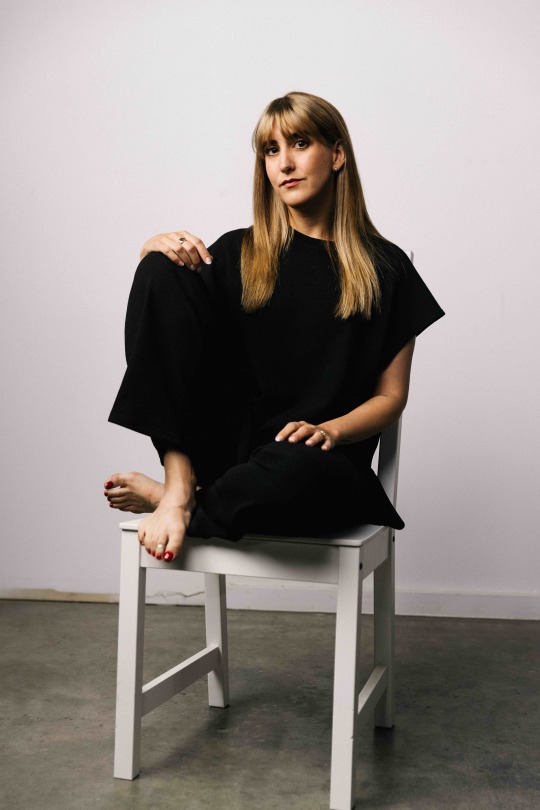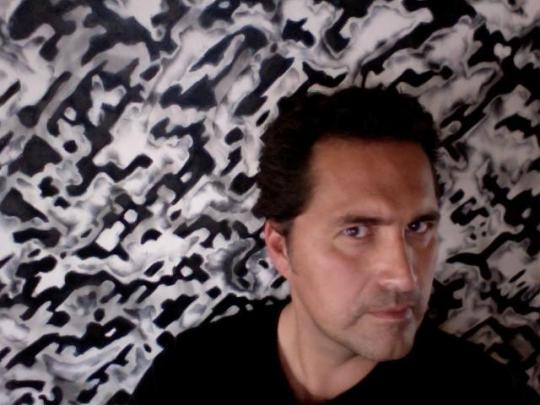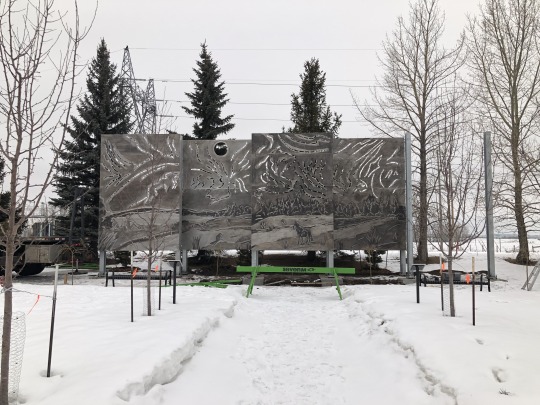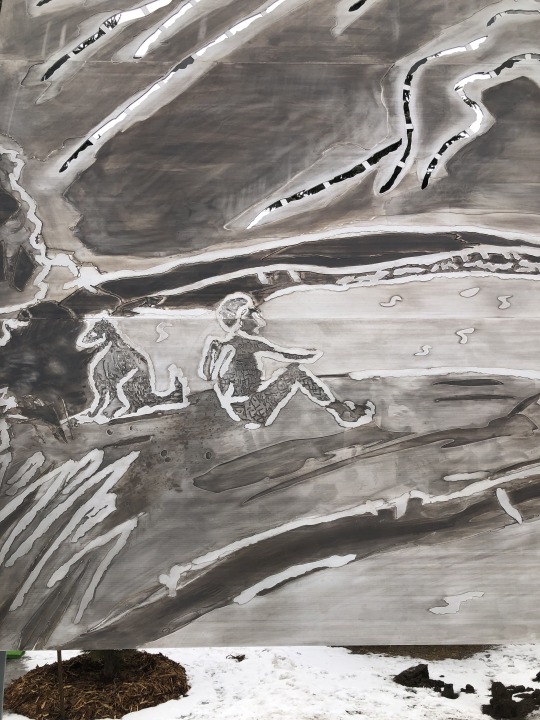#edmontonart

Photo credit: Cooper & O’Hara
Ever thought of our bodies as beacons and receptors in relationship to one another? Interdisciplinary artist Stephanie Patsula has. And a lot. Her live performances and immersive art installations explore her curiosity about the choices we make in relationship to each other and the environment around us. Safe to say, unpredictability isn’t something she shies away from. Just as significantly, neither is collaboration—a gift that continues to influence her work in ways she could not have dreamed. Best of all? It all started here in our arts community—a place she feels upheld, challenged, and understood. This week’s “I Am YEG Arts” story belongs to Stephanie Patsula.
Tell us about your connection to Edmonton and what keeps you working and living here.
I lived between Edmonton and Strathcona County until my early twenties when I relocated to Winnipeg, Manitoba, to start a BFA. It wasn’t until moving back to Edmonton, after a 10-year hiatus, that I started to integrate myself into the local arts. I began an MFA at the University of Alberta in the fall of 2018, as well as an internship at dc3 Art Projects—these two institutions were an excellent entry point for getting to know a variety of individuals at an accelerated pace.
What has kept me living and working here has been an ecosystem of artists, arts initiatives, and creative spaces. Edmonton has a very inviting and supportive art community, and I am truly grateful to all those who have encouraged me to participate within it.
What was it about the arts that made you feel it could be your community?
The arts have always been a space that I felt upheld, challenged, and understood. So with that said, I gravitate towards the arts and arts community wherever I live.
What is it about lens-based work that resonates with you and your artistic sensibilities?
Photography and video work resonate with me, as so much of what I currently create is rooted in the presentation of the live body and live performance. Lens-based practices allow for me to document work and use that documentation as ephemera or objects that can be presented separately or installed as a satellite to live performance(s).
You’ve said that your work “prioritizes embodied research, exploration of site(s), reciprocity through sound and symbology, while attempting to approach concepts of relational ethics, cultural ritual and spirituality.” Can you unpack that a bit for us?
The way that I think about it, embodied research, exploration of site, and reciprocity are almost one in the same. I am motivated by the desire for connection. To feel and be felt, I rely on my body, the places I inhabit, and the people and things around me to activate the relationships found in the performances and installations I build.
I am curious about the choices human beings make in relationship to one another and how a variety of moods or atmospheres can be created depending on the variables or constants in an environment. Currently, my interest is in exploring sensorial memories, and I tend to cite and generate instances of echoic and iconic memory when attempting to create a new narrative through my artwork.


Top: Stephanie with Flexible Hours performing in Iceland, photo provided by Outvert Gallery. Bottom: Whitemud Creek Ravine field recording, photo by Eric Fraser.
Tell us about someone who’s been a mentor to you.
I would like to shift the way that I define the experienced and trusted advisors in my life, opting for a less linear or hierarchical way of characterizing those who have helped to shape me at a variety of intersections of my career. For that reason, I embrace the nuance involved with personal growth and the variety of sources and stages of career that care, support, and shared knowledge can be derived.
I have had the privilege of knowing a wide range of this community’s multifaceted participants and can wholeheartedly state my gratitude to several people who have invested their time and energy towards helping me on my path. Although each of these individuals intersect with the arts in varied ways and with differing perspectives, each of them has underscored the importance of patience, inclusion, and innovation through their own actions, and each of them has generously helped me navigate how to be a better artist and community collaborator.
What makes these folks so fundamental to my time here is that they have led me to trust in my own ability, intuition, and pedagogical approaches. I really respect and value “mentorship” that places the autonomy of the “mentee” at the helm, and I hope that if I ever find myself in a similar position, I can provide the respect, critical feedback, and opportunities I have been afforded during the time I have known each of them.
What’s your favourite and least favourite parts of the creative process?
I would say that both my favourite and least favourite part of my creative process comes from a place of failure, or at least what I would deem failures in the work that I create. I have been unsuccessful in my practice and research on numerous occasions, but the way I interpret and respond to things going wrong has really changed in recent years.
Despite how disheartened I feel at the moment, these uncomfortable circumstances are very pivotal and help me to stay motivated to do better and learn. I find the process of moving forward towards a solution extremely rewarding.
What has the arts community taught you about yourself? And how has it influenced your work?
Being a part of the arts community has taught me the value of creative collaborations amongst peers. This has influenced my work in ways that I could not have dreamed. I am able to co-create projects with skilled technologists and artists in a way that I could not do alone.
Tell us a little about what you’re currently working on.
At the moment I am working on a performance-driven collaboration between myself and live composer Eric Fraser, called Flexible Hours. We are working with a variety of collected and created audio textures to build sound arrangements that vary in mood, tone, and function. The piece we are rehearsing is called “Beacon,” and we are performing on April 28th, in Calgary, as part of The Grand YYC ‘Live & Local’ event.
When you think YEG arts, what are the first three things, people, or places that come to mind?
When I think of YEG arts, I think of:
- Mile Zero Dance—an incredible artist-run space lead by Artist Director Gerry Morita and General Manager Kelly Ruth.
- DIY—Edmonton is full of really inspired pop-up galleries, artists creating and self-funding events, River Valley exhibition spaces, and outdoor shows…
- Grant and project proposal writing with my pal, Eryn, at Kaffa off 109th—because this has been crucial to maintaining the financial support needed to explore and research. It can be a challenging and confusing experience, but is made so much better with a coffee in hand and a friend nearby.
What are you looking forward to most this spring and summer in Edmonton?
I love the River Valley, and it is pretty special that I can access the longest stretch of connected urban parkland in North America. I enjoy venturing out with a number of sound-recording devices and collecting a variety of soundscapes and textures from different sites around the city. There is so much to listen to, and I am really looking forward to doing more of that as the weather gets warmer.
Want more YEG Arts Stories? We’ll be sharing them here all year and on social media using the hashtag #IamYegArts. Follow along! Click here to learn more about Stephanie Patsula and her work.

Sympathetic Resonance still at FAB Gallery, photo by Luke Johnson.
About Stephanie Patsula
Stephanie Patsula is a Canadian interdisciplinary artist. The projects she creates are focused across a variety of processes coalescing in a union of somatic experiencing, experimental sound creation, and lens-based ephemera. Patsula’s work prioritizes the creation of immersive art installations and live performance, which explore bodies as beacons and receptors in relationship to each other. Her processes embrace the unpredictable dynamics of working with new materials, spaces, and bodies by corresponding with them improvisationally—a technique that reflects a personal desire for reciprocity and intimacy through an attentiveness to collaboration and adaptability.
In addition to her art practice, Patsula aims to foster connections within the local art community, working with project spaces and arts incubators to activate sites with programming, interventions, and events. Patsula holds a MFA in Intermedia from the University of Alberta, and she is an MFA candidate of the Sound dept. at the School of the Art Institute of Chicago.

Artist Sanaz Mazinani, photo supplied.
As Edmonton’s newest Downtown green space begins to take shape, we are excited to announce that an artist has been selected for the Warehouse Park public art project. Warehouse Park, located at 106 Street Jasper Avenue to 102 Avenue, is envisioned as an urban oasis and an inclusive, multi-use green space featuring large, open areas that invite citizens and visitors to reflect and explore.
Working alongside the planning and development team for Warehouse Park will be artist Sanaz Mazinani. Sanaz Mazinani (Sānāz Mazināni) (she/her) is an artist, educator, and curator based in Toronto. Working across the disciplines of photography, sculpture, and large-scale multimedia installations, Mazinani creates informational objects that invite a rethinking of how we see, suspending the viewer between observation and knowledge. Informed by the visual rhetoric and confounding presence of contemporary media circulation, her multidisciplinary practice aims to politicize the proliferation and distribution of images, invite critical reflection, and forefront social justice and environmental movements.


Top: Rolling Reflection, 2020, Commissioned by the City of San Francisco for inclusion and permanent installation in the Civic Art Collection. Photo by Tyler Chartier. Bottom: All That Melts: Notes from the Future-Past, 2020, Commissioned by the City of Vancouver, and Vancouver Art Gallery. Photo by Ian Lefebvre and Scott Little.
“I was thrilled to see a new park being created within this amazing neighbourhood,” says Mazinani. “I mean, how often do you get a chance to convert a parking lot into a park! This is a very exciting and ambitious project, and I was moved to learn that I could contribute towards building this remarkable park.”
The project also offers a unique opportunity for the artist, as Mazinani will be included in the project at an early stage of park design planning and development. “Working with the project team from the start will allow me to integrate the needs of the community into the conceptual framework for the piece. As an artist I have many exciting ideas, but each artwork needs to be specific to the specific site and community. And this long-term engagement makes that possible.”
Edmontonians will also have the opportunity to be involved in the public art process through public engagement with the artist. “I hope that the community engagement process will allow me to understand more about what the neighbourhood wants from a public artwork,” explains Mazinani. “For example, is there an interest in a single piece that looks majestic and beautiful, or an artwork that activates the park, through sound or movement in some way?”
Want to have your say in the design of Warehouse Park? Citizens are encouraged to take part in the City of Edmonton’s public engagement running from May 2-22, 2022. Starting on May 2, the project web page (edmonton.ca/WarehousePark) will be updated to include design concepts, a survey, and other related materials. In particular, the survey contains several specific questions Mazinani will be using to guide her work, in addition to the other survey questions which will help to guide many of the concepts of the park. You can find out more about the engagement process on the City of Edmonton website.

Infinite Reflections, 1028 Market Street, San Francisco California. Photo supplied.

Nature, hope, and the art of looking. All three have guided and inspired the work of multidisciplinary artist Adrian Stimson. Whether he’s creating paintings, performance art, installation work, or sculptures, he looks at every project as an opportunity to challenge himself and grow—a chance to create important works that question things in society and open up spaces for people to reflect. For Stimson, that means looking to nature, a place he believes holds all the answers for peaceful existence.
“The story that I’ve heard all my life is, ‘Go to nature. It’s the thing that will teach you the most.’ So throughout my life, and certainly throughout the pandemic, it’s been the thing that’s given me hope. Of course, nature can also be really brutal,” says Stimson, “but generally speaking, it is a calming element. And when you start connecting with the flora and fauna, and observing the animals, and thinking about our relationship to them, I think those understandings of our connectivity to the universe—and to everything—become clearer.”
Nature isn’t the only teacher Stimson’s had. In addition to attending the University of Guelph and the Banff Centre for the Arts, he majored in painting at the then Alberta College of Art and Design (ACAD) where he earned a BFA with distinction, then completed his MFA at the University of Saskatchewan, where performance art, sculpture, and installation became a part of his practice.
Stimson also completed his basic military training as an Able Seaman with the Canadian Armed Forces, is an advocate for social and environmental justice, was on Chief and Council on his First Nation (Siksika) from 1990 to 1999, and was a participant in the Canadian Forces Artist Program, which sent him to Afghanistan in 2010.
Today, Stimson continues to draw on his familiarity with both the military and honouring the fallen in an art installation he’s created for the Northern Lights Military Cemetery in Edmonton. As he explains, “Peace was the theme chosen for this site, so I decided to look to nature for inspiration, which for me, provides that sense of connection to not only our local environments, but to the larger great mystery—which are the tenets of cemeteries, and religiosity, and spiritualism.”


Top: Newly installed artwork, PEACE by Adrian Stimson at Edmonton’s Northern Lights Cemetery’s Military Section. Bottom: Detail of PEACE by Adrian Stimson.
The artwork, titled PEACE, speaks to friendship, harmony, and freedom from violence. The depictions etched on the five, 10’ x 14’ aluminum-steel, laser-cut and patinaed panels reflect the idea of peace, as represented through animal metaphors relating to the military and the natural world around us. Together, the panels create a northern landscape that reflects the natural world, energetic night skies, a connection to the spirits of our loved ones, and the animals that both protect and create wonder in us.
Like any project, there were challenges, but as Stimson explains, that’s all part of the process and one he’s always open to exploring: “Initially we were intending to use corten steel,” says
Stimson, “but in determining what materiality would be best suited for this piece, we settled on aluminum, which is a material I haven’t used before.”
As Stimson goes on to explain, understanding aluminum was a bit of a learning curve at first, until he made an exciting realization: “I’m an interdisciplinary artist, and trained in painting, but I often call myself a closet printmaker. Interestingly enough, in printmaking they use aluminum plates a lot now, so all of a sudden there was this relationship to printmaking in the way the panels were being etched and then patinaed, so for me it was like, ‘Oh my god, this is just like printmaking! All we need is big steamroller and some big pieces of paper!’ Other than that bit of a shift in terms of materiality, which is expected, the process has gone really wonderfully. I have to say, in terms of public art projects, the facilitation by the Edmonton Arts Council, and Behrends, and everybody has been fantastic. We all seem to be on the same wavelength.”
Though Stimson’s interpretation of PEACE holds great meaning for him, he’s hopeful that others will find their own connections to it: “I’m always a believer in creating work and know there are a number of things that the process does for me, be it healing or whatnot. But I also hope that the viewer will go to it on their own, without knowing anything about it, and something within it will trigger something within them—something they needed—a sense of peace, but also wonder—that space of contemplation, and memory, and time.

PEACE by Adrian Stimson at Edmonton’s Northern Lights Cemetery’s Military Section.
What’s next for Stimson? It’s a long and beautiful list. But true to character, it’s a list tempered by respect and gratitude for nature.
“I’ve often thought about earthworks—doing things that transcend time, and space, and being, and that are more in tune with the environment. As artists, we generally don’t focus on us as being wasteful,” says Stimson, “but the fact is the art industry produces a lot of waste, and we have to be mindful of that. So for me, I’m thinking about how to create a practice that’s aware of that, yet still allows us to make things. And I think that’s the biggest challenge in coming years—asking ourselves how we can move forward in a more environmentally conscious way.”
Whatever the answers to that question, you can be sure Stimson will find them where he always looks. As he recalls from his art school days, that process of learning to look is a gift in itself:
“One of the things I remember about my training at ACAD was going outdoors to paint. And I can still remember looking at this tree, and as I was looking at, it was almost as if I was looking at it molecularly. I could see the leaf, I could see the twig and how they connected… and it was that moment that I realized the Art of Looking—how, as artists, we look at things, and take them apart, and put them back together again. And isn’t that the cycle of life and nature itself? That constant renewal and hope. For me, that’s what nature will always be.
Click here to learn more about Adrian Stimson and his work.
About Adrian Stimson
Adrian Stimson is a member of the Siksika (Blackfoot) Nation in southern Alberta, Canada.
Adrian has a BFA with distinction from the Alberta College of Art and Design and MFA from the University of Saskatchewan. He considers himself as an interdisciplinary artist and exhibits nationally and internationally.
His paintings are varied yet his use of black and white monochromatic paintings that depict bison in imagined landscapes are well known, they are melancholic, memorializing, and sometimes whimsical, they evoke ideas cultural fragility, resilience and nostalgia. The British Museum recently acquired two paintings for their North American Indigenous collection.
His performance art looks at identity construction, specifically the hybridization of the Indian, the cowboy, the shaman and Two Spirit being. Buffalo Boy,The Shaman Exterminator are two reoccurring personas. He is also known for putting his body under stress, in White Shame Re-worked, he pierced his chest 7 times, recreating a performance originally done by Ahasiw-Muskegon Iskew, he crawled across the desert in 110 degree heat for What about the Red Man? For Burning Man’s The Green Man and recently dug a TRENCH in a five-day durational performance sunrise to sunset.
His installation work primarily examines the residential school experience; he attended three residential schools in his life. He has used the material culture from Old Sun Residential School on his Nation to create works that speak to genocide, loss and resilience.
His sculptural work includes; Spirit of Alliance, public sculpture in Saskatoon; Bison Sentinel healing gardens of the First Nations University of Canada. And Inii Bison Heart, Bronze Bison was unveiled in the Fall of 2019 in Calgary.
His video work is includes “As Above So Below”, for With Secrecy and Despatch, Campbelltown Arts Centre, NSW Australia 2016, using drone cameras to create a 2 channel video played cinematically on the gallery wall, which spoke to colonial genocide through massacres on our traditional lands. As well as many short video’s of Buffalo Boy and the Shaman Exterminator.
He was a participant in the Canadian Forces Artist Program, which sent him to Afghanistan in 2010. Two exhibitions resulted “Holding our Breath” and Terms of Engagement that toured across Canada.
Adrian was awarded the Governor General Award for Visual and Media Arts in 2018 and REVEAL Indigenous Arts Award – Hnatyshyn Foundation in 2017. He was awarded the Blackfoot Visual Arts Award in 2009, the Alberta Centennial Medal in 2005 and the Queen Elizabeth II Golden Jubilee Medal in 2003.
